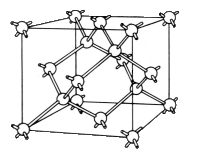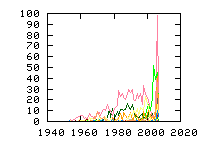« Previous
1
Next »
(19 hits, 1/1)
Showing
10, 25, 50, 100, 500, 1000, all papers per page.
Sort by:
last publication date,
older publication date,
last update date.
- 1. Phys. Rev. B 42, 5765 (1990) , “Bistable interstitial-carbonsubstitutional-carbon pair in silicon”, L. W. Song, X. D. Zhan, B. W. Benson, and G. D. WatkinsA bistable interstitial-carbon?substitutional-carbon pair has been identified in electron-irradiated silicon by a combination of several spectroscopic experimental techniques. In the positive and negative charge states, the stable configuration of the defect involves a carbon-silicon ??molecule??... (Read more)
- 2. Phys. Rev. B 42, 5759 (1990) , “EPR Identification of the Single-Acceptor State of Interstitial Carbon in Silicon”, L. W. Song and G. D. WatkinsAn EPR center labeled Si-L6 is reported which is identified as arising from the singly ionized acceptor state of isolated interstitial carbon (Ci-) in electron-irradiated crystalline silicon. Correlated deep-level capacitance transient spectroscopy measurements locate the... (Read more)
- 3. Phys. Rev. B 47, 6363-6380 (1993) , “Electron paramagnetic resonance of multistable interstitial-carbonsubstitutional-group-V-atom pairs in silicon”, X. D. Zhan, G. D. WatkinsA total of five new electron paramagnetic resonance (EPR) centers are observed in electron-irradiated P-, As-, and Sb-doped silicon. Three are identified as arising from the neutral charge state of the stable configuration and two of the four metastable configurations of an... (Read more)
- 4. phys. stat. sol. (a) 72, 701-713 (1982) , “On the Energy Spectrum of Dislocations in Silicon”, V. V. Kveder, Yu. A. Osipyan, W. Schrter, G. Zoth.Using deep level transient spectroscopy (DLTS) the defects introduced into silicon by plastic deformation are investigated with respect to their capture and emission characteristics. In agreement with what has been found by electron spin resonance (EPR), kind and density of the detected localized... (Read more)
- 5. Phys. Rev. B 32, 6571 (1985) , “Electrical Properties of Dislocations and Point Defects in Plastically Deformed Silicon”, P. Omling, E. R. Weber, L. Montelius, H. Alexander, J. Michel.Energy levels of defect states introduced by plastic deformation of n-type silicon have been studied by capacitance transient spectroscopy. From the observed properties of the defects, it is concluded that two different types of defects are produced. The first type is interpreted as point defects... (Read more)
- 6. phys. stat. sol. (a) 168, 73 (1998) , “Self-Interstitials in Silicon Irradiated with Light Ions”, B. N. Mukashev, Kh. A. Abdullin, Yu. V. Gorelkinskii.The behavior of self-interstitials in silicon which was irradiated with light ions (protons and -particles) and electrons was explored by monitoring known impurity interstitial centers (Ci, Ali, (Si-O)i) with deep level transient spectroscopy (DLTS) and electron... (Read more)
- 7. Mater. Sci. Eng. B 58, 171-178 (1999) , “Self-Interstitial Related Reactions in Silicon Irradiated by Light Ions”, B. N. Mukashev, Kh. A. Abdullin, Yu. V. Gorelkinskii and S. Zh. TokmoldinRecent deep level transient spectroscopy (DLTS), electron paramagnetic resonance (EPR) and infrared (IR) spectroscopy data on interactions of self-interstitial with carbon, aluminium, oxygen and hydrogen in silicon irradiated by light ions are reviewed. Self-interstitial behaviour in silicon was... (Read more)
- 8. Appl. Phys. A 30, 1 (1983) , “Transition Metals in Silicon”, E. R. Weber.A review is given on the diffusion, solubility and electrical activity of 3d transition metals in silicon. Transition elements (especially, Cr, Mn, Fe, Co, Ni, and Cu) diffuse interstitially and stay in the interstitial site in thermal equilibrium at the diffusion temperature. The parameters of the liquidus curves are identical for the Si:Ti — Si:Ni melts, indicating comparable silicon-metal interaction for all these elements. Only Cr, Mn, and Fe could be identified in undisturbed interstitial sites after quenching, the others precipitated or formed complexes. The 3d elements can be divided into two groups according to the respective enthalpy of formation of the solid solution. The distinction can arise from different charge states of these impurities at the diffusion temperature. For the interstitial 3d atoms remaining after quenching, reliable energy levels are established from the literature and compared with recent calculations. (Read more)
- 9. Phys. Rev. B 32, 7129 (1985) , “Electron-Nuclear Double Resonance of Titanium in Silicon: 29Si ENDOR”, D. A. van Wezep, R. van Kemp, E. G. Sieverts, C. A. J. Ammerlaan.The Si-NL29 EPR spectrum, which is associated with the positive charge state of interstitial titanium in silicon, was investigated by electron-nuclear double resonance. Hyperfine-interaction parameters of 17 shells of silicon neighbors, comprised of 214 atoms, could be determined. These parameters... (Read more)
- 10. Mater. Sci. Eng. R 33, 135-207 (2001) , “Comprehensive characterization of hydride VPE grown GaN layers and templates”, H. MorkoçGaN community has recently recognized that it is imperative that the extended, and point defects in GaN and related materials, and the mechanisms for their formation are understood. This is a first and an important step, which must be followed by defect reduction before full implementation of this... (Read more)
- 11. Phys. Rev. B 51, 16721 (1995) , “Electronic states associated with dislocations in p-type silicon studied by means of electric-dipole spin resonance and Deep-Level Transient Spectroscopy”, V. Kveder, T. Sekiguchi, K. Sumino.Dislocation loops consisting of long and straight segments of 60? and screw parts were introduced in p-type Si by deformation under a high stress at a relatively low temperature. Electronic states associated with such dislocations were investigated by means of electric-dipole spin resonance, with... (Read more)
- 12. phys. stat. sol. (b) 221, 625-631 (2000) , “Identification of the Gold-Lithium Defect L1 in Silicon with the Trigonal Centre Au2--(Li+)3 by Electrical, Optical and Magnetic Resonance Spectroscopy”, B. Langhanki, J. ?M. SpaethN-type silicon doped with gold and lithium was investigated by Electron Paramagnetic Resonance (EPR) and Deep Level Transient Spectroscopy (DLTS), using two sets of samples with different defect concentrations of both gold and lithium. Photoluminescence (PL) on both sets of samples allowed to... (Read more)
- 13. Appl. Phys. Lett. 43, 563-565 (1983) , “Characteristic electronic defects at the Si-SiO2 interface”, N. M. Johnson, D. K. Biegelsen, M. D. Moyer, S. T. Chang, E. H. Poindexter, P. J. CaplanOn unannealed, thermally oxidized silicon, electron spin resonance reveals an oriented interface defect which is termed the Pb center and identified as the trivalent silicon defect. Deep level transient spectroscopy (DLTS) reveals two broad characteristic peaks in the... (Read more)
- 14. Physica B 302-303, 249-256 (2001) , “Hydrogen-Enhanced Clusterization of Intrinsic Defects and Impurities in Silicon”, B. N. Mukashev, Kh. A. Abdullin, Yu. V. Gorelkinskii, M. F. Tamendarov and S. Zh. TokmoldinFormation of intrinsic and impurity defect complexes in hydrogenated monocrystalline silicon is studied. Hydrogen was incorporated into samples by different ways: either by proton implantation at 80 and 300 K, or by annealing at 1250°C for 30–60 min in a sealed quartz ampoule containing... (Read more)
- 15. J. Appl. Phys. 88, 1784-1787 (2000) , “Electron Spin Resonance Centers Associated with Oxygen Precipitates in Czochralski Silicon Crystals”, M. Koizuka, H. Yamada-Kaneta.We have previously concluded that the oxygen-precipitate-associated defects that we identified by the deep levels at Ev + 0.30 eV and Ec–0.25 eV were the Pb centers generated in the interface between the oxygen... (Read more)
- 16. Phys. Rev. Lett. 60, 460 (1988) , “Bistable Defect in Silicon: The Interstitial-Carbon-Substitutional-Carbon Pair”, L. W. Song, X. D. Zhan, B. W. Benson, G. D. Watkins.By combining several spectroscopic techniques, we have observed a new type of bistable center in electron-irradiated silicon and have identified it as an interstitial-carbon?substitutional-carbon pair. The positive and negative charge states of the defect share a common stable configuration which... (Read more)
- 17. J. Appl. Phys. 88, 6265 (2000) , “Doping of n-type 6H–SiC and 4H–SiC with defects created with a proton beam”, A. A. Lebedev, A. I. Veinger, D. V. Davydov, V. V. Kozlovski, N. S. Savkina, A. M. Strel?chukDeep centers in n-type 4H–SiC and 6H–SiC irradiated with 8 MeV protons have been investigated by capacitance spectroscopy and electron paramagnetic resonance (EPR). Samples were fabricated by sublimation epitaxy or commercially produced by CREE Inc. Research Triangle Park, NC. It is... (Read more)
- 18. Physica B 308-310, 730 (2001) , “Deep level defects in sublimation-grown 6H silicon carbide investigated by DLTS and EPR”, K. Irmscher, I. Pintilie, L. Pintilie and D. Schulz6H-SiC bulk single crystals grown by physical vapor transport (PVT) were investigated by deep-level transient spectroscopy (DLTS) and electron paramagnetic resonance (EPR). One of the observed deep level defects was identified as isolated tungsten on Si sites by EPR. The electron spin of could be... (Read more)
- 19. Physica B 340-342, 15-24 (2003) , “Defects in SiC”, E. Janz?n, I. G. Ivanov, N. T. Son, B. Magnusson, Z. Zolnai, A. Henry, J. P. Bergman, L. Storasta, F. CarlssonRecent results from studies of shallow donors, pseudodonors, and deep level defects in SiC are presented. The selection rules for transitions between the electronic levels of shallow donors in 4H–SiC in the dipole approximation are derived and the ionization energy for the N donor at... (Read more)
« Previous
1
Next »
(19 hits, 1/1)
Showing
10, 25, 50, 100, 500, 1000, all papers per page.
Sort by:
last publication date,
older publication date,
last update date.
All papers (3399)
Updated at 2010-07-20 16:50:39
Updated at 2010-07-20 16:50:39
(view as: tree
,
cloud
)
| 1329 | untagged |
Materials
(111 tags)
Others(101 tags)
Technique
(46 tags)
Details
(591 tags)
Bond(35 tags)
Defect(interstitial)(18 tags)
Defect(vacancy)(15 tags)
Defect-type(19 tags)
Element(65 tags)
Energy(8 tags)
Isotope(56 tags)
Label(303 tags)
Sample(17 tags)
Spin(8 tags)
Symmetry(15 tags)

